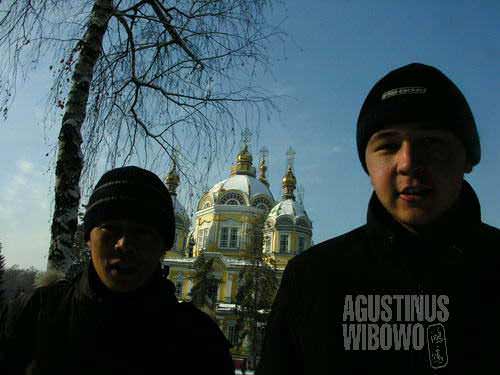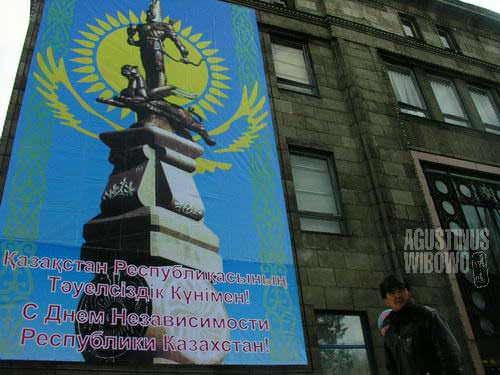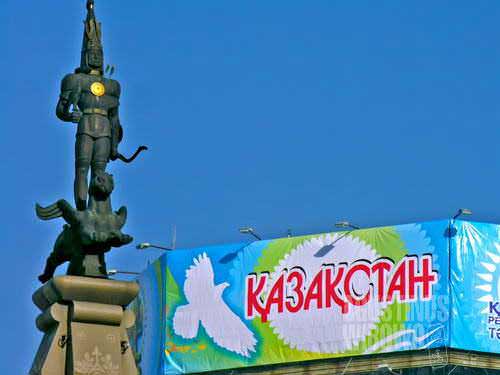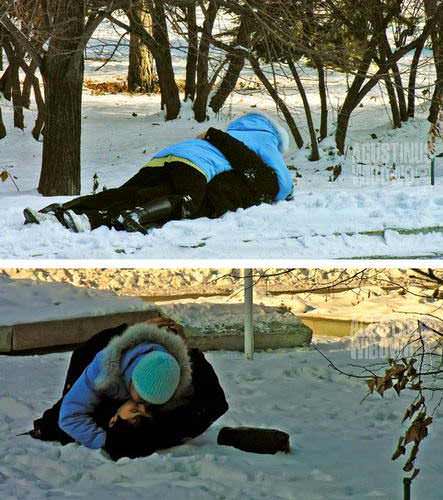Almaty – the Golden Man
During my stay in Kazakhstan, today was the first time I saw a sunny day in Almaty. The city suddenly became lovely and friendly. Somehow now I started to understand how this city had a lovely name, Almaty, which was the original form of its old name, ‘Alma Ata’, which literally means Father Apple. The Chinese call this name as ‘Alamutu’, which might be the closest form the Chinese spelling could make to this city’s name in Silk Road time. Anyhow, it was said that Almaty’s apples were as big as coconut, and it was said the best apples produced here at that time. Now, for a poor Russian dwellers like Lyubova, apple is a luxury in this ‘apple city’, as the price of apples was far beyond their budget.
I got used already with Almaty’s high cost of price, and as people coming from financial power below poverty line, I started to know the strategy to keep living in low budget. I started to do self-catering from the Zelyonii Bazaar (Green Bazaar). There were many Korean ladies selling the famous Korean cabbage salad and prickles. There was also a cheap Chinese restaurant with the best Uyghur laghman on menu. I became their loyal customer.
There were some Kazakh boys near Almaty’s renowned Zenkov Cathedral in the middle of Panvilov Park. This is a Russian orthodox church, built in the Tsarist time and used not even a single nail. When I asked the boys to pose little bit in front of the cathedral, they refused. “No, we are Muslims. This building is from the kafirs (unbelievers),” said one of them. These university students understood, as Muslims, it was not appropriate to take photos in front of a Christian church. These boys, in the other way, were also alcohol drinkers. They don’t read Arabic script, as most of Central Asian Muslims. Some Kazakh Muslims also consume horse meat (in their national dish of beshbarmak, literally means ‘five fingers’) and pork (in the best quality of Russian sausages). While it was still debatable whether horse is eatable or not, eating pork was certainly forbidden in Islam. If the Kazakh are open minded about this, as they were the least strong in term of religion compared to other Central Asians, I was surprised that these students could be touchy to be photographed in front of a Russian church.
Maybe the reason was not simply religion.
An interesting fact about Islam in Central Asia is that historically the Tatars and Kazakhs were strong Muslims and had a powerful movement against the communist regime of Russia. The Tatars also converted the nomadic people and Kazakh Muslim even had their own mufti (leader of Muslim Religious Board) while other 4 Central Asian republics shared one mufti in Tashkent. The intense influence of Russification and Communism in Kazakhstan turned this country to be the least Islamic compared to other nations in Central Asia. Many of Kazakhstan young Muslims even couldn’t recognize the Arabic script of ‘Allah’ and ‘Muhammad’ even if the script was inscribed on their necklaces. The reason of having script of ‘Allah’ and ‘Muhammad’ was merely as identity without understanding. Russian influence was very strong all time. Kazakhstan was the last country in Central Asia to proclaim its independence, separated from Russia, as it was the most reluctant to be separated from the Soviet Union and preferred to keep being part of the great empire.
The country was preparing its 15th anniversary of its independence, to be held on December 15. Workers were busy to put banners of flags and coat-of-arms along the streets and around Respublika Alangy.
The Respublika Alangy was a square where the Monument of Independence was located. On the top of the monument there was a replica of the Golden Man (Altyn Adam). Altyn Adam is a warrior costume from golden pieces, estimated from the BC period, which was evacuated near Almaty. Now it was an icon of Kazakhstan, a symbol of a brave, prosperous, and strong nation to welcome the arrival of golden ages in Kazakhstan. The Altyn Adam, in new vision of Kazakhstan, now stood on a golden leopard. I learnt later that Nazarbayev vision of the creation of the country was to bring Kazakhstan as an economic leopard, comparable to Eastern Asian economic tigers (Indonesia, Malaysia, South Korea, and Thailand). Indonesia at that time (1991 when Kazakhstan got its independence) was seen as a strong power, and it was an economic tiger (which then replaced by a snow leopard here) that became the ideal of successful Kazakhstan economic development. Now the snow leopard was ripping its golden age from the oil and gas booming, while this Asian tiger, Indonesia, suffered of hunger as oil and gas booming had passed.
I walked through the Respublika Alangy. The sunny day was much welcomed by the people suffering the harsh winter. Children played on ice. Old men walked in the park. A young couple, a Kazakh boy and girl, lied on the snow next to the street. The boy was lying on the snow and the girl on his body. They kissed, romantically, erotically, on the snow, in public sight. People around them can be ignored. I wondered whether it was due to the wealth the country now enjoying, the cosmopolitan city where all values mixed together, the secularism in life, or simply desire to be westernized. I have never seen scene like this in other parts of Central Asia. Or I was not in Asia now?













Leave a comment